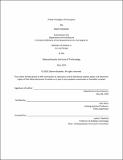| dc.contributor.advisor | Axel Kilian. | en_US |
| dc.contributor.author | Abubakar, Zidane. | en_US |
| dc.contributor.other | Massachusetts Institute of Technology. Department of Architecture. | en_US |
| dc.date.accessioned | 2020-10-08T21:27:18Z | |
| dc.date.available | 2020-10-08T21:27:18Z | |
| dc.date.copyright | 2020 | en_US |
| dc.date.issued | 2020 | en_US |
| dc.identifier.uri | https://hdl.handle.net/1721.1/127854 | |
| dc.description | Thesis: S.B. in Art and Design, Massachusetts Institute of Technology, Department of Architecture, May, 2020 | en_US |
| dc.description | Cataloged from PDF version of thesis. | en_US |
| dc.description | Includes bibliographical references (pages 50-51). | en_US |
| dc.description.abstract | What we experience on a day to day basis, our reality, is dictated by what we see, hear, feel, taste and smell - what we sense. These daily experiences are directly tempered by our perceptions. On one end of the spectrum, the hearing or visually impaired may experience fewer senses than most. On the other end of the spectrum exist synesthetes - people with the condition known as synesthesia, and who experience a reality with blended senses. Synesthesia is a condition in which stimuli in one sense involuntarily and automatically trigger perceptions in another sense. The unique experience that this extra layer of perception presents could potentially revolutionize the human experience by offering a new paradigm of creation and perception. Unfortunately, synesthesia is a very rare phenomenon that only affects a very small portion of the population. There have been some successful endeavors to replicate a variety of different forms of synesthesia, from art installations to audiovisual performances. While they are interesting utilizations of synesthesia, these replications aren't accessible or widely known to the general public, and so the potential for this revolution has not been fully realized. This thesis asks the question: How can we learn from synesthesia to discover and design new, useful, and accessible ways of perceiving the world? This thesis theorizes possible ways of creating new sensory experiences that utilize synesthesia as a model in order to create new, enhanced perceptions that are as accessible as possible to the general public. Specifically, this thesis will focus on creating a new sensory experience, the realm of which will be influenced by results from a survey of the MIT population, with Arduino tools, as they grant access to a great deal of senses and are relatively cheap and easy to construct. | en_US |
| dc.description.statementofresponsibility | by Zidane Abubakar. | en_US |
| dc.format.extent | 72 pages | en_US |
| dc.language.iso | eng | en_US |
| dc.publisher | Massachusetts Institute of Technology | en_US |
| dc.rights | MIT theses may be protected by copyright. Please reuse MIT thesis content according to the MIT Libraries Permissions Policy, which is available through the URL provided. | en_US |
| dc.rights.uri | http://dspace.mit.edu/handle/1721.1/7582 | en_US |
| dc.subject | Architecture. | en_US |
| dc.title | A new paradigm of perception | en_US |
| dc.type | Thesis | en_US |
| dc.description.degree | S.B. in Art and Design | en_US |
| dc.contributor.department | Massachusetts Institute of Technology. Department of Architecture | en_US |
| dc.identifier.oclc | 1196034332 | en_US |
| dc.description.collection | S.B.inArtandDesign Massachusetts Institute of Technology, Department of Architecture | en_US |
| dspace.imported | 2020-10-08T21:27:17Z | en_US |
| mit.thesis.degree | Bachelor | en_US |
| mit.thesis.department | Arch | en_US |

